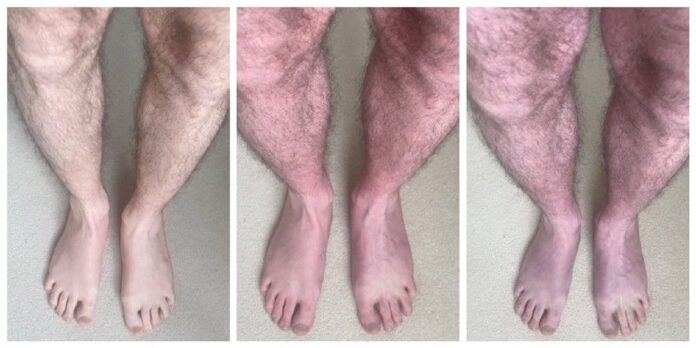Long COVID, the prolonged array of symptoms experienced by individuals recovering from COVID-19, continues to be an area of intense research and medical attention. While respiratory and systemic symptoms have taken the forefront, a lesser-known manifestation, characterized by blue discoloration of the legs, has emerged.
The study seeks to shed light on this distinctive symptom, “blue legs,” in the context of Long COVID, aiming to increase awareness and understanding among healthcare professionals and the general public.
In a paper published in The Lancet, Dr. Manoj Sivan from the University of Leeds discussed a case study about a 33-year-old man. This man developed acrocyanosis, which means that blood pooled in his legs and caused them to turn blue.
When he stood up, his legs turned red within a minute. Over time, they became even bluer, and the veins in his legs became more visible. After about 10 minutes, the color of his legs became much darker, and he felt a heavy and itchy sensation in his legs. But when he returned to sitting or lying down, his legs returned to their original color within two minutes.
The patient mentioned that he started noticing this change in the color of his legs after he had COVID-19. Doctors diagnosed him with postural orthostatic tachycardia syndrome (POTS). It means that his heart rate would usually increase when he stood up.
Long Covid is a condition that makes many body parts not work properly and causes many problems. People with Long Covid have many symptoms that make it hard to do their daily tasks. This condition also messes up a part of the body called the autonomic nervous system, which helps control blood pressure and heart rate.
One of the problems that can happen with Long Covid is something called acrocyanosis. It means that body parts, like the legs, can turn blue because of issues with the autonomic nervous system. It has been seen before in kids with problems with their autonomic nervous system after a viral illness.
Dr. Sivan, Associate Clinical Professor and Honorary Consultant in Rehabilitation Medicine at the University of Leeds’ School of Medicine, said, “This was a striking case of acrocyanosis in a patient who had not experienced it before his COVID-19 infection.”
Some might not know that having blue legs could be a sign of Long Covid and a problem called dysautonomia. They might feel worried when they see this happening to their body. Even doctors might not know this blue legs thing is connected to Long Covid.
It’s important to spread more information about dysautonomia in Long Covid. This way, doctors can know what’s happening and help patients correctly.
Dr. Sivan’s previous studies have found that many people with Long Covid often have dysautonomia and a condition called POTS. These problems affect the body’s heart rate and blood pressure systems.
Dysautonomia is also seen in other long-lasting conditions like Fibromyalgia and Chronic Fatigue Syndrome (ME). Dr. Sivan said, “We need more knowledge about dysautonomia in these conditions, better ways to check and treat it, and more research to understand it better.”
Researchers are doing more work in the field of autonomic medicine. They’re developing a test that people can use at home if they have symptoms like dizziness or fainting. This test can help in conditions like Long Covid, chronic fatigue syndrome, fibromyalgia, and diabetes.
Journal reference:
- Nafi Iftekhar, Manoj Sivan, et al., Venous insufficiency and acrocyanosis in long COVID: dysautonomia. The Lancet. DOI: 10.1016/S0140-6736(23)01461-7.
